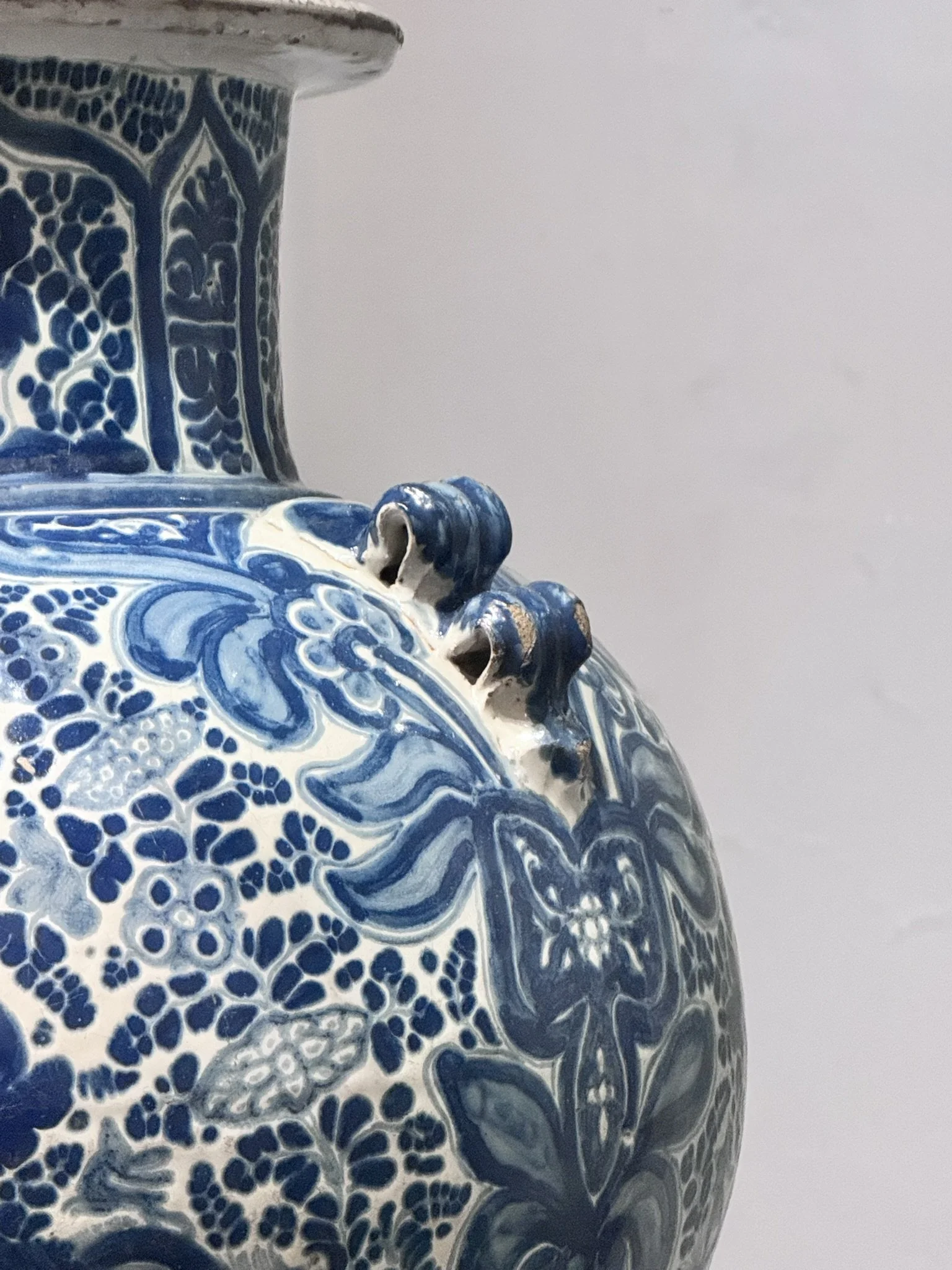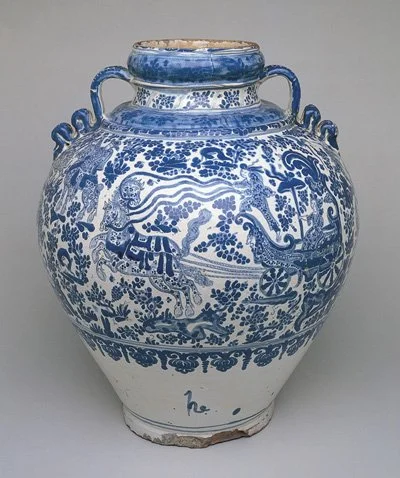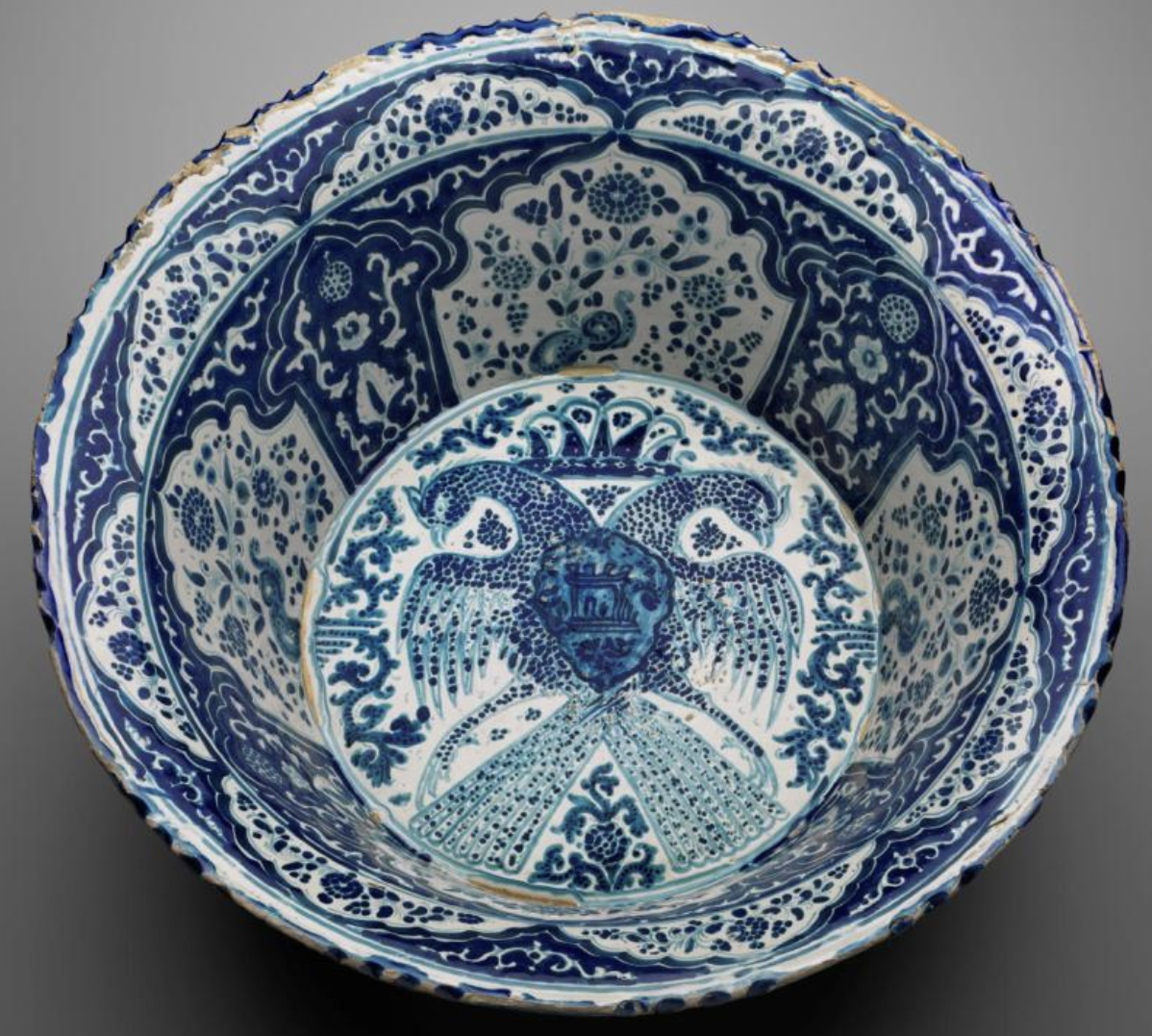Remnants of a Global Mesoamerica: Chinese-Islamic Syncretism in Early Modern Novohispanic Ceramics
By Natalia Ramirez
Image of Talavera Poblana pottery, Museo Franz Mayer, Mexico City.
Image courtesy of Natalia Ramirez and Liliana Kong.
In the seventeenth century, within the workshops of Puebla de los Ángeles, in colonial Mexico, potters used clay and glaze to tell profound stories of cultural exchange, colonialism, and the nature of style. Their vessels, stark with cobalt and bright white, are rich in visual elements that trace back to Islamic ornament, Chinese porcelain, and Iberian ceramic tradition. A single Talavera Poblana jar can thus serve as a testament to the evidential history of global interactions. Beneath its glaze exists a longstanding dialogue between the Chinese artisans who established blue and white porcelain wares, Islamic aesthetics that shaped early porcelain traditions, and the colonial Mexican potters who, encountering these objects through the Manila galleon trade, reimagined them to tell their own stories and adapt them to their own needs.
Artist(s) not currently known (New Spain), Serpentine Jar, ca. 1650–1700, Tin-glazed earthenware with cobalt blue decoration, Height: 54 cm, Museo Franz Mayer, Mexico City.
Image courtesy of Columbia University, Department of Art History and Archaeology, Digital Hispanic Monographs Project.
At first glance, the Jar with Serpentine Handles (ca. 1660, attributed to Damián Hernández) appears ubiquitously Novohispanic, a local work of Puebla’s thriving talavera pottery industry. Yet its visual elements are undeniably transoceanic, both Atlantic and Pacific. Its structure and design recall the bulbous kuan vessels of China, characterized by a narrow base and neck and a rotund midsection. Its dense, swirling decoration avoids negative space, referencing the horror vacui of Islamic aesthetic traditions. A narrative band of European-style figures covers the midsection, featuring depictions of abstracted foliage that reference both Asian and European motifs. The result is a layered and nuanced hybridity: Chinese in palette, Islamic in spatial awareness, European in figuration, Mexican in material.
This hybridity was no accident. From the sixteenth century onward, the Spanish Manila–Acapulco galleon route carried Chinese porcelain, silk, and lacquer (among other goods) to the port of Acapulco, where goods entered New Spain and circulated to Mexico City, Puebla, and beyond. In elite homes, imported porcelain was displayed alongside silver, ivory, and devotional paintings, to demonstrate wealth, access, and mobility. But its influence extended deeper: local artisans driven by the demand to create imitation ware studied these pieces as models, adapting their motifs to local materials. For Puebla’s potters, Chinese porcelain offered not only exotic appeal reminiscent of the mystified ‘East’ but also formal instruction, exemplifying how to balance ornament and structure, how to manipulate cobalt blue in layered washes, and how to treat the vessel as a pictorial field.
Yet the Chinese porcelain that arrived in Mexico was already the product of earlier cultural exchanges. The blue-and-white aesthetic that Europe and the Americas came to associate purely with China had material roots in Persia. From the fourteenth century, cobalt oxide mined in Persia and Central Asia supplied the coveted pigment for Chinese underglaze decoration, where the blue-and-white tradition was born. These pieces grew in reverence both locally in China, and as export ware along the Silk Routes and along early maritime trades. Thus, before Chinese ceramics reached Mesoamerica, they already embodied centuries of West Asian and Islamic design logic, existing as part of a global aesthetic history long before the term’s recognition.
When these Chinese porcelains arrived in Mexico, they encountered a visual culture already present in its own Islamic inheritance. Through Spain’s long history of Islamic ornamentation, which spanned conquest and exchange, the traditions had integrated Iberian art and architecture, persisting well beyond the Reconquista. The Mudéjar tradition (the blending of Christian and Islamic design in post-conquest Spain) prominently shaped the decorative arts that colonists brought to New Spain and other Spanish colonies. The tilework (azulejos) that adorned churches and convents in Puebla, the carved wood ceilings (artesonados) in monasteries, and even the geometric patterns on manuscript borders all inherit the history of Islamic design. Thus, when New Spanish artisans first saw Chinese porcelain, they recognized something familiar: the dense surface ornament, dynamic ornament designs, and a profound attention to symmetry that they were familiar with in Iberian aesthetic hybridity.
Artist(s) not currently known (New Spain), Basin (Labrillo), ca. 1650–1700, Tin-glazed earthenware with cobalt blue decoration, Height: 21 cm; Diameter: 45.7 cm.
Image courtesy of the Museum of Fine Arts, Boston (Accession no. 2012.500).
The Serpentine Jar exemplifies how these converging traditions are housed in the metaphorically resilient ceramics. A related example, a Basin (Labrillo) now in the Museum of Fine Arts, Boston, expands this network of influences. The vessel’s broad shoulders and narrow neck suggest reference to East Asian prototypes, while its scrolling vegetal designs and blue-on-white palette validate the connection to Chinese traditions. Yet its body is earthenware, not porcelain, testifying to its nature as a local reinterpretation rather than imitation. This jar’s ornament takes influence from both Islamic geometric order and Chinese symmetry. The result is neither derivative nor purely decorative; it is a visual and material convergence that uniquely emerged in colonial Mexico, where global elements were fused with local ideas, needs, and circumstances.
To call such objects "hybrids" risks generalizing their complexity. They are better understood as syncretic translocalizations, material acts of integration, adaptation, and preservation in which artisans localized foreign designs while retaining their unique regional circumstances. Novohispanic potters were not passive recipients of imported objects; they were active participants in a global dialogue of cultural preservation, documentation, and interpretation. By adapting Chinese-Islamic motifs into talavera, they inscribed the Pacific world onto the very surface of colonial life.
The social meanings of these ceramics were equally layered. In elite households, blue-and-white pottery symbolised refinement and ‘worldliness.’ Its Islamic-Chinese visual heritage may not have been consciously recognised, yet it lent the objects a mystified quality of ‘antiquity’ and ‘prestige’ to their most often Iberian collectors. At the same time, these ceramics testify to the complicated economies of the Early Modern empire. Cobalt mined in Persia, porcelain fired in China’s Jingdezhen, and clay shaped in Puebla converged in a singular object; in other words, local objects culminated in a global enterprise of material and cultural trade. The Manila galleon trade, often described as a commercial corridor, was equally an aesthetic one: it transported not only commodities but also ideas.
By the eighteenth century, the talavera tradition had become firmly established as a marker of Mexican identity, its global origins largely forgotten. Yet the Islamic and Chinese origins remained intrinsic in the craft itself. The Serpentine Jar thus stands as more than a purely visual artifact; it is a material remnant of intercultural relations. To study it is to recognize that colonial art was never provincial, never isolated. Instead, it was an active entity in global exchanges, where Islamic aesthetics reached Mesoamerica through China, and local artisans gave those influences a unique reimagination.
Bibliography
Connors McQuade, Margaret. “Talavera Poblana and the Transpacific Trade.” In Made in the Americas: The New World Discovers Asia, edited by Dennis Carr, 82–85. Boston: MFA Publications, 2015.
de los Santos, José María. The Manila Galleon and the Trans-Pacific Trade: Connections between the Philippines, Mexico, and China, 1565–1815. New York: Routledge, 2015.
Harris, Jonathan. The Globalization of the Early Modern World. Cambridge: Cambridge University Press, 2011.
Husselman, Elinor M. “Majolica and Tin-Glazed Pottery: The Technique and Its Development.” Bulletin of the Detroit Institute of Arts 30, no. 2 (1951): 24–26.
Pinzón Ríos, G. 2022. “Sobre Transpacific Engagements: Trade, Translation and Visual Culture of Entangled Empires (1565–1898).” Estudios de Historia Novohispana, no. 68: 219–224. https://doi.org/10.22201/iih.24486922e.2023.68.77767.
Priyadarshini, Meha. Chinese Porcelain in Colonial Mexico: The Material Worlds of an Early Modern Trade. Palgrave Studies in Pacific History. Cham: Palgrave Macmillan, 2018. https://doi-org.ezproxy.st-andrews.ac.uk/10.1007/978-3-319-66547-4.
Russo, Alessandra. The Untranslatable Image: A Mestizo History of the Arts in New Spain, 1500–1600. Austin: University of Texas Press, 2014.



